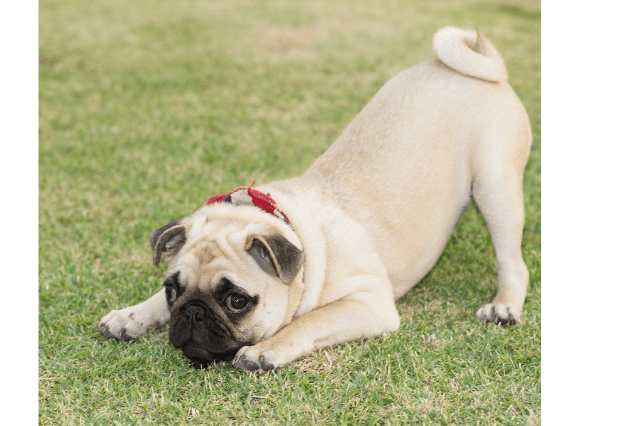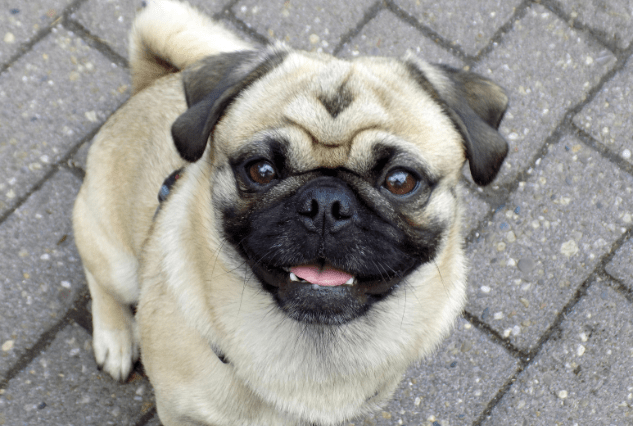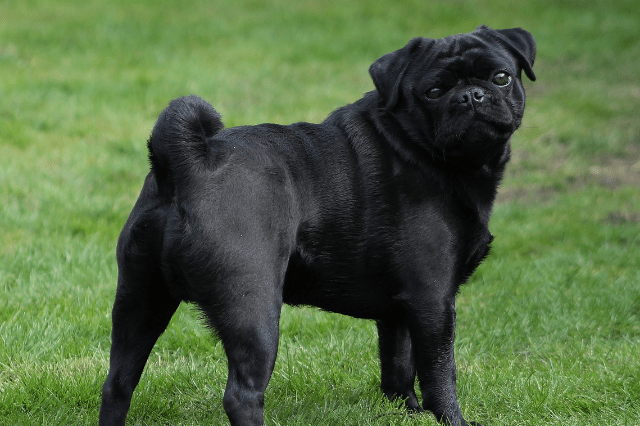All The Beautiful Pug Colors

Pugs are renowned the world over for their cute personalities and squishy faces. Couple that with the most adorable walk you’ll ever see in any canine breed out there and you’ve got one popular pup. A little mischievous yet adored by all dog owners, this dog breed is perfect for people who enjoy spoiling their pets. You would be surprised to know how many colors you can find in this small animal.
But what’s the rarest of Pug colors? Do Pug colors define the personality of the Pug breed? What’s the difference between a Fawn Pug and a Silver Fawn? And how does a Pug’s color affect its overall health? If it’s pug information you’re looking for, you’re in the right place! Read on to find out more about these beautiful dogs.
The Pug Breed: Understanding What Matters
While purebred and rare Pugs are adored for their beautiful colors, there are other factors that Pug owners should consider. Your Pug’s health and temperament are most important. It’s easy for pet lovers to become obsessed with rare pug colors that make their pup stand out among the rest. But our primary focus should be to care for its physical and emotional well-being.
Pug markings and coat patterns are simply add-ons, but making sure our Pug dogs are happy, healthy, and treated with care can bring more satisfaction in the long run.
What Does The Kennel Club Say About The Origin Of Pugs?
Pugs have a distinct, amazing history. Originating from China, the breed traces back almost 2,000 years. Treasured and adored by emperors and a favorite among influential families, Pugs have always been known as wonderful house dogs.
The American Kennel Club (AKC) officially recognized the Pug breed in 1885. Following suit, the Pug Dog Club of America was established in 1931. Since then, the affluent Pug’s appeal has increased dramatically over the years. They are currently one of the most popular dog breeds. Enough of the history lesson, let’s move to the fun part!
According to the AKC, this small but muscular dog is known to have expressions similar to humans. With their sparkling round eyes and wrinkled brow, they seem to display several emotions just like us!
Most Pugs are great as pets or with other dogs living in a pack. A moderate climate is ideal for Pugs to be healthy and joyful. Pugs enjoy their meals, and there’s a wide variety of healthy food options for both Pug puppies and adult dogs of the breed. Since Pugs are prone to obesity, it’s a good idea to watch their diet and calorie consumption. You might want to check out the best fresh dog food or have a look at the BarkingTalk Food page for healthy treat ideas. These dogs love to snuggle indoors, which makes it easy for them to gain weight.
Are Rare Color Pugs Recognized By Kennel Clubs?
The AKC recognizes two standard Pug colors: Fawn and Black. The Canadian Kennel Club recognizes Silver Fawn in addition to Fawn and Black. Unfortunately, rare colored Pugs are not acknowledged by breeders as they do not meet the breed standards.
The main objective of dog breeders is to maintain the standards for each breed. Some breeders tend to charge extra for “rare” or “designer breeds”, but it’s best to choose wisely because these are usually not purebred animals.
On the other hand, Pug owners can confirm their pup’s breed history with a DNA test. Most dog shows only allow purebred animals, and you’ll likely need a reputable breeder if you’re looking to enter your pooch in a contest.
Understanding The Pattern Of Pug Colors
What Are The Most Common Pug Colors?
While there are a variety of pug colors and coat patterns, Purebred Pugs include Fawn and Black as standard colors recognized by most kennel clubs. Some variations of the Fawn Pug include Silver, Silver Fawn, Apricot Fawn, and Apricot Pugs.
Fawn Pugs
Although a plethora of Pug colors exist, Fawn Pugs make up about ⅔ of the Pug population. Their coat varies from a light cream to a medium cream color. Fawn coat pugs are one of the lightest of the breed with a light sliver cream coat color.
Some Fawn color Pugs can have undertones of silver, known as Silver Fawn Pugs. Others have undertones of orange or red and are called Apricot Pugs. The wrinkles in a Silver Fawn or Fawn Pug tend to create further variations in coat colors. Fawn Pugs are currently some of the most popular dogs.

Black Pugs
Black Pugs are the second most common coat color for this breed. As recognized by the Pug Dog Club, these pugs have a deep solid black coat from the top of their head to the tip of their tails. Black is the result of a dominant gene, and your Black Pug probably has one Pug parent with a black coat.

What Are The Most Rare Pug Colors?
Brindle Pug
Brindle is the rarest color for a purebred Pug. This pattern gives a striped appearance with a combination of black and light-colored markings. A Brindle Pug can often come with a hefty price tag owing to its unique coat color.
While most Brindle Pugs have a light brown coat with black markings, a reverse Brindle Pug can have a black coat with a light brown pattern. Brindle Pugs are so rare that they make up roughly 1% of all Pugs. Other breeds can have a brindle coat such as the brindle Pitbull.
Other rare colors are often a result of crossbreeding. Some of these rare Pug colors include Black and Tan, Blue Merle, Chinchilla, Pied, and Pink. Yes, there are Pink pugs in the world as well and we can’t get over it either.

White Pugs
With a gorgeous solid white coat, White Pugs are a result of a cross with a French Bulldog or a Pekingese.
Blue Pugs
Blue Pugs are a result of both parents having black coats. Contrary to the label, Blue Pugs are not entirely blue. Their coat has a very dark shade of black with a blue undertone visible in sunlight. These Pugs almost always have black puppies because of the two dominant genes for black coats from both parent pugs.
Merle Pugs
Merle Pugs are a result of crossbreeding a non-Merle Pug and a dog that has the Merle gene. This often results in a coat that has mottled coloring much like that of Australian Shepherds.
Merle Pug patterns are often very distinctive with a mix of fawn and black coats. Blue Merle Pugs have a coat that’s black with a bit of white.
You can find out about other merle dog breeds here.
Chocolate Pugs
Although genuinely a rare kind, Chocolate Pugs exist. Born to a Fawn Pug and Black Pug, the single known Chocolate Pug in the US is Koto.
Panda Pugs
Pandas are adorable, so how can a Panda Pug not be? These Pugs have white coats with black patches around their eyes and ears, much like the appearance of Pandas. A Panda Pug may have one or two blue eyes.
Black and Tan Pugs
Imagine a pug-sized Rottweiler but with a lovable attitude. That’s right! This cute Pug is quite rare and has both black and tan coats.
Albino Pugs or Pink Pugs
As the name suggests, these rare pups are known for their light pink skin and white coat. They have very fine hair, and their lips, ears, paws, and noses are also pink. They’ll often have gray-blue eyes.
Albino Pugs can suffer from many health issues and breeders shouldn’t be breeding especially for albino pups.
Chinchilla Pugs
These rare colored Pugs are leucistic dogs. This medical condition results in very low levels of melanin in the DNA. Often mistaken for Albino Pugs, Chinchilla Pugs have slightly darker colored fur around their ears, eyes, nose, and paws. The Chinchilla DNA in their blood results from a cross between a White Pug and a light Chinchilla.
Pied Pugs
Having an equal amount of black-to-white or brown-to-white in the Pug’s coat means you’ve got a Pied Pug. These pugs will have an attitude a bit similar to a French Bulldog or Boston Terrier. This is probably due to the fact their bloodline has one or the other.
Platinum Pugs
Platinum Pugs fall in a color category between Silver Fawn Pugs and Black Pugs. They have a deep dark grey coat and are easy to identify. You’ll notice their fur has an equal amount of black and silver hair giving them this ashy dark tone.
Common Markings On Your Pug’s Coat
All Pugs have markings on their furry little bodies, whether they’re Apricot pugs, Silver Pugs, or Silver Fawn. These characteristic features do not impact a Pug’s overall behavior or health. They merely represent the appearance of the Pug dog breed. The standard Fawn Pug and Black Pug tend to have more of the original Pug features. Some of these markings include:
Mask
This is the most common and prominent feature of a Pug and is familiar to all. Purebred or Fawn Pugs in particular have this black patch of fur that starts under their chin and goes all the way up over their muzzle and eyes.

Trace
The trace of a Pug is a dark line beginning at the back of the neck going all the way down to the tail. It can be wide or narrow and could possibly disappear or grow wider as the pup matures. According to the Canadian Kennel Club, features like the trace are visible in original Pugs, showing off a contrast between the coat color, mask, and trace.

Thumbprint
The signature thumbprint of a Pug is an AKC show-stopper. The darker it is the better your pug’s chances of winning. This is the diamond-shaped patch of dark fur on your pug’s forehead. It may grow bigger and darker as your pup matures.

Smuttiness
A mix of black hair and light hair on a Pug’s coat is known as smuttiness. This trait is not considered in dog shows.
White Paws
Another feature that is not recognized as a true Pug’s markings is having white paws. Your pug might have white paws when it has white fur on its chest body or face, this is largely due to cross-breeding or the Pug’s genes.
Does Color Affect The Health Of Pugs?
Pug colors generally do not affect their overall health. That being said, most purebred dogs such as the Fawn Pug or Black Pug, are at risk for certain health complications. Several factors lead to a greater risk of infection or health issues for these standard-color pups.
Because of their small bodies and typically low energy levels, purebred Pug dogs seem to be the perfect pets. But their short muzzles may lead to respiratory issues such as Brachycephalic airway syndrome.
Sporting a short snout, these dogs are not as capable of regulating body temperature as dogs with longer snouts. Many mixed-breed pugs, such as the Retro Pug, Chug or Puggle, have been bred to have slightly longer snouts to help them breathe better.
Additionally, the Pug’s adorable corkscrew tail makes it all the more difficult for them to clean their bodies on their own. Their recognizable skin folds are the perfect habitat for skin infections and parasites. All of these factors largely depend on their genetics, the health of their parent dogs, and the care provided by their owners. So coat color isn’t to blame.
Health issues may also happen in rare colored Pugs. But this is mostly an outcome of irresponsible breeding. The most noticeable health problems are seen in Albino Pugs. These Pugs are a result of selective breeding which may lead to greater health complications.
Due to a lack of pigmentation in their skin, they are more sensitive to sunlight and have a high chance of developing skin cancer. They may also suffer from pain and irritation in the eyes and skin.
Does Color Affect The Personality and Temperament Of A Pug?
Not entirely. Coat colors are largely due to pigments that affect only the hair of Pug dogs. The assumption that a Pug’s coat color is an indication of its personality or temperament is not based on research but could be a personal experience for some pet owners.
Digging deeper into the role of genetics, we know that coat colors are a result of crossbreeding. This means that some genes or characteristics of the Pug puppy will likely come from either or both of the parents.
Since there is no true way to predict the outcome of crossbreeding, there isn’t a direct link between temperament and coat color. However, knowing more information about the genetic history and parent dogs can help Pug owners understand specific elements of their Pug’s temperament.
This could help link the behavior for training purposes. Such knowledge could be useful if your Pug has particular health problems or underlying conditions. Importantly, most Pugs are trainable and very loving. This means their temperament could be a combination of their genetics and the way you raise them as part of your family.

Conclusion
There are plenty of options for you to choose from when it comes to rare color Pugs. While these unique colors and patterns may be tempting, it’s not always the best choice to opt for a crossbred pooch. What interests you in getting one? If you’re looking forward to dog shows, a purebred standard color Pug is your best option. These include a Black Pug, Fawn Pug, or Silver Fawn Pug.
If your goal is to adopt one that has a rare coat color, it’s best to look for a breeder through a trusted contact. It’s also a good rule of thumb to get precise information on the parents of the dog that you’re interested in purchasing. You can find a lot of useful breeder tips from the Pug Dog Club of America.
And regardless of whether you’re considering rare color Pugs or purebred Pugs, make sure the pup is healthy. At the end of the day, your Pug’s health and comfort are what truly matter.
